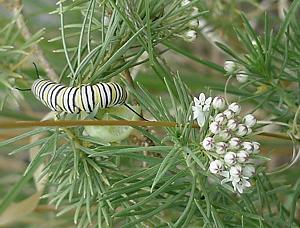Asclepias linaria
Asclepias linaria
Asclepias linaria is a species of the genus milkweed ( Asclepias ) in the subfamily of the milkweed family ( Asclepiadoideae ) within the family of the dogbane family ( Apocynaceae ). It is native to the southwestern United States to northern Mexico.
- 5.1 Literature
- 5.2 Notes and references
Description
Appearance and leaf
Asclepias linaria grows as a perennial herbaceous plant with woody base, or as low, fragile shrub. It reaches heights of growth from 50 to 200 cm (or 30 to 150 cm). The relatively slender, multi-branched stem axis are upright or ascending and can be very woody, more or less. They carry the scars of shed leaves. The young shoot axes are initially pubescent and finely verkahlen later.
The dense, alternate and spirally arranged leaves are nearly sessile. The sparsely hairy or bald leaf blades are needle-shaped with a length of 2 to 5 cm and a width of about 1 mm. The leaf margins and the Spreitenspitze are bent toward the bottom.
Inflorescence and flower
The flowering period extends from April to November. Fast terminal or permanently and individually to some of the top nodes ( more nodes ) standing on a moderately slender, 0.5 to 2 cm long, hairy inflorescence stem Doldiger inflorescence contains few to many flowers. The flower stems are slender, 1.5 to 2 cm long and also hairy.
The relatively small, hermaphroditic flowers are radial symmetry and fünfzählig. The five finely hairy sepals are long lanceolate with a length of about 3 mm and fused only at their base. The corolla is wheel-shaped and bent back. The greenish white, usually slightly pink or purple petals flushed have 4 to 5 mm long Kronblattzipfel. The short conical and about 1 mm high and as wide pedunculated Gynostegium is orange or cream-colored. The at a length of 3 to 4 mm wide, ovate, erect or ascending, staminal Nebenkronzipfel are hood -shaped. The inner secondary extension is horn- shaped, lies almost entirely on the staminal Nebenkronzipfel, but is shorter than this. The stylus head has a conical cut about 1.5 mm long and 2.5 to 3 mm wide. The wings of the anthers are 1 to 1.2 mm and the corpuscle 0.25 mm long. The pollinia measure 0.8 mm in length.
Fruit and seeds
On curved peduncles are erect fruit. The smooth, slightly hairy to bald follicles are broad spindle-shaped with a length of 4 to 5 cm and a width of 1 to 2 cm. The oval with a length of about 6 mm seeds have a to about 2 cm long, white hair.
Similarities
Asclepias linaria is over the entire area quite uniform and belongs to the species of the genus Asclepias, the woody most. The young plants can be easily confused due to the needle-shaped leaves with pine seedlings.
Synecology
Asclepias linaria is in their area of distribution is an important food plant of the Monarch butterfly (Danaus plexippus).
Occurrence
The distribution area of Asclepias linaria extends from northern Mexico to the southwestern United States ( states of California, Arizona and New Mexico). Locality data in Mexico, there is for the states of Chihuahua, Coahuila, Durango, Guanajuato, Jalisco, México, Michoacán, Morelos, Nuevo Leon, Oaxaca, Puebla, Querétaro, San Luis Potosi, Sonora, Tamaulipas, Tlaxcala, Veracruz, Zacatecas and the direct federal capital district Mexico City.
The vertical distribution extends between altitudes of about 800 to 1,750 meters. Asclepias linaria comes in open oak, pine or juniper woodlands before on dry ridge of limestone, stony hills, sandy slopes of volcanoes, canyons and arroyos. It spreads from those locations on dry pasture and wasteland.
Taxonomy
The first publication of Asclepias linaria took place in 1791 by Antonio José Cavanilles in Icones Plantarum et Descriptiones, 1, p 42, Table 57 synonyms for Asclepias linaria Cav. are: Asclepias filiformis Sessé & Moc, Asclepias pinifolia Greene.. The specific epithet means flat linaria similar.










